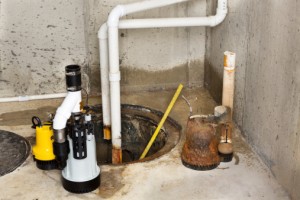 Toiling tirelessly in the corner of your basement or crawl space, the sump pump’s work is occasionally overlooked but nevertheless extremely important to your home’s plumbing. These unassuming machines keep your home snug and dry, protecting it from floods, mold, and other water-related damage. Because the sump pump is generally located at a distance from a home’s main living areas, it can be difficult to recognize problems. Checking your sump pump regularly for the following signs is an important step to keeping your pump, and your basement, in great shape for years to come.
Toiling tirelessly in the corner of your basement or crawl space, the sump pump’s work is occasionally overlooked but nevertheless extremely important to your home’s plumbing. These unassuming machines keep your home snug and dry, protecting it from floods, mold, and other water-related damage. Because the sump pump is generally located at a distance from a home’s main living areas, it can be difficult to recognize problems. Checking your sump pump regularly for the following signs is an important step to keeping your pump, and your basement, in great shape for years to come.
Non-Stop Action
If your sump pump is running continuously, even when there is no water in your basement, you should address the problem immediately. Sump pumps that are running unnecessarily are not working too well, they are working improperly. Some reasons for this may include:
- An incorrectly sized pit: If the sump pit is too small for the amount of water that collects, the sump pump will have to work harder than necessary to keep the pit empty.
- A broken or missing check valve: The check valve is a valve that keeps water the pump has pumped out of your home from flowing back in. If this valve is cracked or missing, the majority of the water being pumped will fall right back into place.
- Stuck switches: Occasionally, the vibrations caused by the sump pump can knock switches out of joint, causing them to stick and the pump to remain running.
Too Much Water, Not Enough Time
Depending on the weather and the water table in your area, sometimes a single sump pump is not sufficient to do the job. There is simply too much water and not enough time or energy available to eliminate it. A professional can determine whether upgrading your single sump pump to a pump capable of dealing with higher volumes is wise, or adding another pump altogether is necessary. Professionals can also determine the best placement for each pump to guarantee maximum efficiency.
A Clog in the Works
Sump pump systems without a lid often collect dirt and debris. This can clog the pump and switches, making your sump pump work sluggishly or even stop altogether. Sump pumps can also be contaminated by dirt and debris located on the bottom or along the sides of the sump pit. Professionals know how best to clean clogged pumps and switches safely and efficiently. They can also install pumps with tight lids to prevent future problems.
While it may seem unimportant during warmer, drier seasons to clean or upgrade your sump pump, maintaining your equipment year round is the best way to be certain it is ready to work for you when the rains begin to fall. If your sump pump is experiencing any of these problems or you are unsure of its performance, please visit Econowestair to have it examined by a professional.






